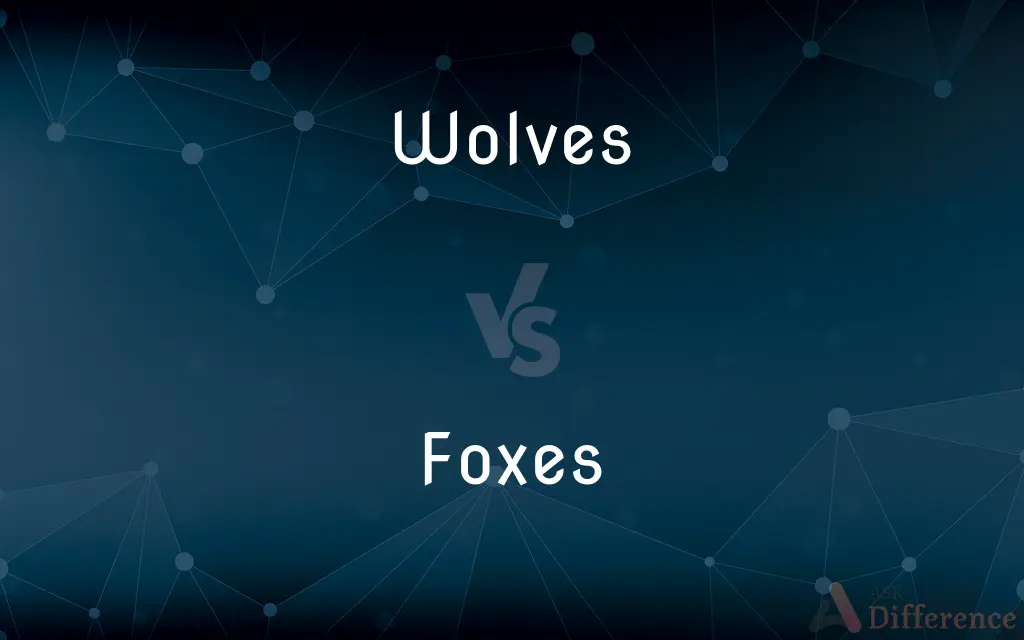Wolves vs. Foxes — What's the Difference?
By Tayyaba Rehman & Maham Liaqat — Published on February 18, 2024
Wolves are large, social canines known for their pack behavior, whereas foxes are smaller, more solitary animals with a reputation for cunning.

Difference Between Wolves and Foxes
Table of Contents
ADVERTISEMENT
Key Differences
Wolves and foxes are both members of the Canidae family but differ significantly in many aspects, from physical characteristics to behavior and habitat preferences. Wolves, belonging to the genus Canis, are known for their size and strength, which makes them one of the top predators in their ecosystem. They have a complex social structure and live in packs, which are crucial for hunting and survival. Foxes, on the other hand, are smaller canines from various genera including Vulpes, and are known for their agility and cunning. They tend to be solitary or live in small family groups rather than in large packs.
Wolves have a more uniform coat color, ranging from gray to white, black, and brown, foxes display a wider variety of colors, with the red fox being the most recognizable due to its bright fur and bushy tail. This diversity in appearance reflects the adaptability of foxes to various environments, from deserts to forests and even urban areas. Wolves, conversely, are primarily found in wilderness areas where they can roam large territories as required by their hunting lifestyle.
In terms of diet, wolves are obligate carnivores, heavily reliant on large ungulates like deer, elk, and moose, which they hunt in coordinated packs. Foxes have a more varied diet that can include fruits, insects, small rodents, and birds, showcasing their opportunistic feeding behavior. This dietary flexibility allows foxes to survive in a broader range of environments compared to wolves.
The howl of a wolf is one of the most iconic sounds in the animal kingdom, serving as a means of communication within the pack and to declare territory. Foxes, while also vocal, produce a wide range of sounds, and their "scream" is particularly notable. These vocalizations serve different purposes, including mating calls and signaling distress.
Understanding the differences between wolves and foxes underscores the diversity within the Canidae family, with each species adapted to its niche within the ecosystem. Whether it's the wolf's role in maintaining healthy ungulate populations or the fox's versatility, both play critical roles in their respective habitats.
ADVERTISEMENT
Comparison Chart
Size
Larger, with adults averaging 40-175 pounds.
Smaller, with adults usually under 30 pounds.
Social Structure
Live in packs with complex social hierarchies.
More solitary or live in small family groups.
Habitat
Prefer remote wilderness areas.
Adapt to a wide range of environments, including urban areas.
Diet
Primarily large ungulates.
Omnivorous, with a diet including insects, rodents, and plants.
Vocalization
Known for their howling.
Produce a variety of sounds, including barks and screams.
Compare with Definitions
Wolves
Large predators known for their pack behavior.
The wolves howled in the distance, signaling their presence.
Foxes
Produce a variety of vocal sounds.
At dusk, the sharp bark of a fox broke the silence.
Wolves
Apex predators in their ecosystems.
Wolves play a crucial role in controlling the deer population.
Foxes
Small, agile canines with distinctive bushy tails.
The red fox darted across the field, its tail a bright flame against the green.
Wolves
Primarily found in wilderness areas.
Wolves roam vast territories in the northern forests.
Foxes
Known for their adaptability to various environments.
Foxes have made a home in both rural and urban settings.
Wolves
Known for their iconic howl.
At night, the haunting howl of wolves echoes through the valley.
Foxes
Exhibit a wide range of colors and species.
From the arctic fox to the desert fox, their adaptability is remarkable.
Wolves
Have a complex social structure.
The alpha wolf leads the pack with authority.
Foxes
Have a diverse diet, including fruits and insects.
In the garden, the fox quietly hunted for mice and berries.
Common Curiosities
What is the primary difference between wolves and foxes?
Wolves are larger and live in packs, while foxes are smaller, more solitary animals.
Are wolves more dangerous to humans than foxes?
Wolves are naturally wary of humans and rarely pose a threat, whereas foxes are generally less dangerous due to their smaller size.
Which habitats do wolves prefer?
Wolves prefer remote wilderness areas with ample space to roam and hunt.
Can foxes adapt to urban environments?
Yes, foxes are highly adaptable and can thrive in both rural and urban settings.
Can wolves and foxes interbreed?
No, wolves and foxes cannot interbreed due to significant genetic differences.
Do foxes have the same social structure as wolves?
No, foxes tend to be more solitary or live in smaller family units, unlike the complex pack structure of wolves.
Are foxes omnivores?
Yes, foxes have an omnivorous diet that can include insects, rodents, fruits, and vegetables.
Do both wolves and foxes mate for life?
Wolves often form monogamous pairs, while foxes' mating behaviors can vary widely among species.
Why do wolves howl?
Wolves howl to communicate with pack members and to mark their territory.
How do wolves and foxes impact their ecosystems?
Both play crucial roles, with wolves controlling ungulate populations and foxes affecting smaller prey and plant life through their omnivorous diet.
What do wolves primarily eat?
Wolves are carnivores that primarily hunt large ungulates like deer and elk.
How do foxes differ in appearance from wolves?
Foxes are generally smaller, with more varied coat colors and a distinctive bushy tail.
Can wolves be found in desert areas like some fox species?
Wolves are less adaptable to extreme environments like deserts compared to some fox species.
Are wolves endangered?
The conservation status of wolves varies by region, with some populations considered endangered due to habitat loss and persecution.
What sounds do foxes make?
Foxes can make a variety of sounds, including barks, screams, and howls, depending on the situation.
Share Your Discovery

Previous Comparison
Warcraft vs. Warhammer
Next Comparison
Google vs. Wolfram AlphaAuthor Spotlight
Written by
Tayyaba RehmanTayyaba Rehman is a distinguished writer, currently serving as a primary contributor to askdifference.com. As a researcher in semantics and etymology, Tayyaba's passion for the complexity of languages and their distinctions has found a perfect home on the platform. Tayyaba delves into the intricacies of language, distinguishing between commonly confused words and phrases, thereby providing clarity for readers worldwide.
Co-written by
Maham Liaqat















































